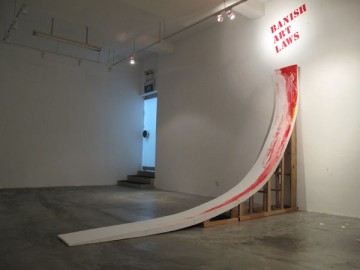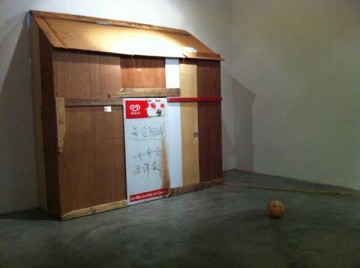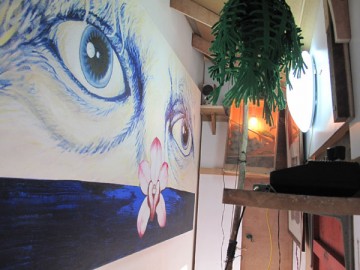First, before I start, I would like to complain a bit: Singapore prides itself on being a city of electronic gadgets and connectivity-on-the-go. There are many people watching videos on their handheld devices on the bus, the subway, and in line at the post office. Though not as dumb as Americans who text-and-drive, a lot of people here are staring at their little screens while walking. As skilled as they are at walking and watching videos at the same time, it still very much annoys me. So if you are one of those people, please stop watching crappy TV shows or crappy movies. Enjoy your bus ride. Enjoy your walk. Enjoy waiting in line at the post office!
Okay, back to art: I met Kai Lam about a year ago at a performance event at the now-defunct Post Museum. Kai has been a very active person in the art community over the last fifteen years, especially in performance circles. In 2003, he co-founded Future of Imagination (FOI), an international performance event. In 2009, Kai co-initiated Rooted In The Ephemeral Speak (R.I.T.E.S) which gives local and international artists a regular platform to showcase performance practices and time-based art.
This past June, Kai had his fourth solo show in Singapore. The show was called Untitled (Wildlife). Inside the Substation gallery space, there was actually very little to see. There was a wooden container constructed out of scrap materials. On the other side of the gallery there was a wooden ramp. On the adjacent wall there was a text that read “Banish Art Laws.”
Before the opening, Kai sent out email invitations which included a letter in which he described the night he spent on Pulau Ubin, a small island off the main Singapore Island. Here is an excerpt:
“For an unassuming while, I was humored by my own helplessness in such ‘wilderness,’ possessing a limited knowledge of the natural environment, and told myself to learn more about it when I got back to ‘civilization.’ I then picked up the fishing line-spool, [where] clipped onto the line is a note, written with waterproof ink: “For all my wants, here are my unwants…. XXX,” and tied to the end of the fishing line is a rock-bait. I cast the line into the air, towards the sea, the trapping debris flew in a slow-motion movement, about twenty meters above the water surface just like the distance (I thought) of my close proximity to the wild boars, and predictably splashed into the steady-moving sea waves. I felt the rock-bait hit the bottom of the seabed and the sea’s underwater current, pulling on my rock-bait invisibly. The wait continues again.”
Those who know a bit about the geography of Singapore know that Pulau Ubin presents a contrast to the main Singapore Island. Most roads are still made of dirt, there are lots of stray dogs, and trees that are not planted. This place is as natural or wild as Singapore gets. I like the imagery Kai Lam sets up for the viewers, and their strong metaphorical content: away from the center (civilization, materialism, modern progress, etc.), the artist-figure awaits on the periphery with a fishing line. The fishing line is a double-sided one; once it hooks, it binds the debris to the artist, and the artist to the debris.
I caught up with Kai Lam to ask him about his exhibition, as well as the state of performance art in Singapore.
Mike HJ Chang: I found the letter your wrote to be very romantic. It provides the audience with an image of the artist as a contemplative figure. Can you talk a little bit about the idea behind it, and how the letter relates to the exhibition?
Kai Lam: For me, the exhibition is about developing something outside of how I usually work. I wanted to break out of my usual norm and process. Therefore, the time spent waiting, contemplating, thinking, all these processes become more important than the exhibition itself. That’s why the exhibition space is so empty to start with. For me, the show is about a certain invisibility. So in this aspect, the letter deals with my position as an artist at the moment. My position, not just in Singapore, but overseas, in a general way. When I travel to Europe, I feel that when people find out that you are an artist, then they think that what you do is something very important. But in Asia, overall there are different perceptions about artists. A different outlook and mentality about what artists do, and what artists should do. Therefore the letter is a metaphor about being on the outside, away from the city, away from the mainstream core. I have been thinking a lot about how we can position ourselves as artists in Asian society. Not by promoting our importance, but by promoting a way of thinking of the artist as a social commentator, a philosopher, and a thinker. Artists are an important part of the process for a nation maneuvering in this kind of climate. Singapore, like many post-colonial states, is still very young, still experiencing all kinds of newness, like democracy, institutional transparency, capitalism, etc.
When I tell people I do performance art, they say, “performance artists are lazy artists” [both laugh]. And this is coming from the art community! It is not part of my agenda to disrupt what people think of as the role of an artist, but instead it is to promote the idea that all these rules, borders, stereotypes, lines, demarcations are within ourselves, and it is our own responsibility to see behind these things. So that’s how the ramp ties in. The ramp is dedicated to my artist-peers and art colleagues. It is an apparatus for someone to take off, to be in flight. Right next to it I put the text “Banish Art Laws” on the wall. I think on a surface level people can see it as a piece about artistic rights, government policies, and censorship. Of course culture cannot be controlled that way, no way! But it is actually more about the personal level. As artists, we all have a certain way of doing things, our own protocols and methodology. So in that sense I want to do away with those preconceived notions of art. To be truly free, we must free ourselves from our own constraints.
Also inside the wooden structure, which looks like a hut, I put all the works I made over the last two years. It is more of a storage container then a proper sculpture. By doing this, I want to question how one looks at art and how one makes art. There are certain expectations when one goes to an art exhibition, and when those expectations are not met, one questions oneself. In the case of my exhibition, I made all the works almost invisible, to emphasize that all of it is still in process. This also highlights the ephemeral processes of art-making in our highly materialistic art world and our consumerist society.
In the hut there is a painting of J.B. Jeyaretnam’s eyes. Mr. J.B. Jeyaretnam has been a very important figure in Singaporian politics because he fought endlessly against the majority party. When he passed away three years ago, few took notice. So at that time I started to make work based on him. I feel that the opposition party in Singapore is very oppressed. Even after Mr. Jeyaretnam died, he was not recognized as someone who contributed to society. I feel so very disappointed that our society has treated someone like that. So I painted his eyes, because even though there is some sadness in them, the also show determination.
MC: Besides being an artist, you also spend a great deal of time organizing performance events. Can you talk about the development of performance art in Singapore over the last ten years?
KL: It is growing, but at a very slow pace…but it has been moving in a positive direction over the last six or seven years. I feel though, that performance art is still seen as a niche within the bigger art community. It used to be like a sideshow, you know. When they want some live entertainment for a big exhibition they would ask couple of performance artists [both laugh]…and that was about it. No discussion, no regular meetings and lectures. The support we are getting now is encouraging, but in comparison to the support that other forms of art get the sum is still pretty small. To me it is almost like tokenism. Though various government funding agencies have been very instrumental in developing R.I.T.E.S. and Future of Imagination.
MC: Maybe this is a good time to talk a little bit about what happened before 2004, when funding for performance was banned for ten years.
KL: Yeah, okay. I was an art student in 1994. At that time I feel the energy was very good. It was quite an exciting time. I witnessed many individuals coming together to do performance art. And then the controversy happened and the Singapore government banned funding for all performance art until 2004. I called it The Dark Age of Performance Art in Singapore. Nobody knew what was really going on. Some people thought that performance art was banned, but in reality, it was really only funding that was banned. [‘The Dark Age of performance art,’ a phrase jokingly coined by Kai Lam, is well documented here by art writer Lee Weng Choy. In a performance event in 1994, artist Josef Ng made a piece responding to police arrests of individuals engaging in homosexual activities. In his performance Ng shaved his pubic hair. At the same event, Sharon Tham did a performance responding to the over-sensationalized reporting of The New Paper articles on moshing at rock concerts. Josef was on trial for performing indecent acts in public. As a result, Josef Ng and Shannon Tham are banned for life from receiving grants from NAC].
Anyway, it threw the performance circle into a bit of confusion. Lee Wen was quite an important figure at that time because he continued to practice and promote performance art. It is through these kinds of small steps that government authorities notice that they cannot ignore this form of art for long.
The fact that NAC banned performance art and forum theater for so long makes me think it is not a neutral organization. It is discriminating against a certain form of art. As far as I know, the National Art Council or the government has never addressed or commented on the artists who are banned for life. Not to mention Josef Ng was only 21 years old, and was a student at the time. Now performance art is supported again, but they never re-addressed the issue regarding those two artists. I find it very problematic. Funding bodies should be more neutral. NAC is a statutory board under MICA (Ministry of Information, Communications, and the Arts); therefore they may be partial in their funding policies, because they would have to fall in line with the larger Singapore government agenda.
Woon Tien Wei (co-founder of Post Museum) and Jeremy Hiah and myself were still doing and organizing performance events during the Dark Age. In 2004, when they lifted the ban on funding, Lee Wen, Khairuddin Hori, Jason Lim and myself wanted to test the situation and see how it went. So that’s the beginning of Future of Imagination. We invite many international artists around the world to be part of the events, and they can come here and share and exchange ideas with local artists. It contributes to the expanded practice of performance and its development, through discussion and workshops and interactions between artists. It also creates a new audience base, as local audiences are more curious and tend to watch plays, concerts and performances when they come from overseas. It is perhaps for this reason that the art council here understood the importance of the artists’ network that justifies the support of these projects. And really, things have come a long way in the last six or seven years.
****
After talking to Kai, I spent a little bit of time thinking the idea of “invisibility.” The hut Kai built for the exhibition, which contains works he chose not to show, can be read as a form of self-enforced exile. And the ramp reinforces the idea that, for whatever reason, we are our own prisons, artist or no artist. The politician Mr. J.B. Jeyaretnam, whom Kai feels strongly about, is made invisible by external force: the failure of the Singapore government to recognize the value of opposition within a political structure. Performance artists Josef Ng and Sharon Tham are banned from art funding in their own country for artistic expressions that went against the grain of the government’s cultural agenda. Their endeavors were silenced and their lives forever changed, as consequences of what the Arts Council defines as art and as not art.
Here in Singapore the counter-cultures, various forms of sub-cultures, and opposition political parties are still struggling to stand against the mainstream (ideology, culture, political party, or otherwise). I don’t know, maybe it really is a tiny island, and there are just not enough spaces for everyone and every idea. It is much easier to follow the norm then to fight against it. See the closing of Post Museum and Evil Empire, two of the handful of alternative art spaces that are not sponsored by any forms of government funding. (As well as Yale’s recent mission to set up liberal arts education here). There is certainly nothing wrong with having a strong national identity, but shouldn’t it be defined by a number of voices within society? Chaotic it might be, but isn’t giving people the power to be different the ultimate goal of a high-standard society we all want to be a part of? And in that ideal place, opposition is more valued, and visible.
Why has NAC not addressed the ban on Josef Ng And Shannon Tham? What happened between 1994 and 2004? Did they change their minds about performance art? Did they forgive what Ng and Tham did? Did they realize it was art, only after ten years? Or did they realize that it is not their job to figure out what is and what isn’t art?
The Singapore government, like most governments and institutions around the world, would rather have its population not remember the hideous stuff from the past. Why waste time reconciling when we are supposed to march ahead? The majority of the population probably feels fine about it, as they go on with their jobs and various forms of weekend entertainments. But there is a special group of people who do not forget easily, who hold grudges for a long time, and who are always, and I mean always, complaining about things: artists.






